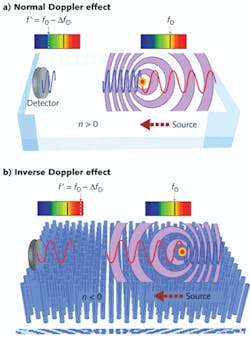When a wavelength source and an observer are moving in relation to each other, a fundamental frequency shift is observed called the Doppler effect due to wave compression or extension in a positive refractive-index media. In astronomy, for example, light is shifted to shorter wavelengths (blue shift) for objects moving toward Earth, while light is shifted to longer wavelengths (red shift) for objects moving away; in fact, Doppler shifts in spectral lines are used to study ejections from our own Sun.
Soviet physicist Victor Veselago theorized in 1968 that in negative-refractive-index metamaterials, the opposite would occur: A red-shifted signal would be detected for a wavelength source approaching a detector, and a blue-shifted signal would be seen for a source moving away from a detector. Until now, the inverse Doppler effect had only been observed at radio frequencies. But a group of researchers from the University of Shanghai for Science and Technology (USST; Shanghai, China), Jiangxi Normal University (JNU; Nanchang, China), and Swinburne University of Technology (SUT; Melbourne, Victoria, Australia) have now observed the inverse Doppler effect at optical frequencies in a photonic-crystal metamaterial.1
Designing the experiment
Observation of the inverse Doppler effect is extremely challenging because the frequency is too high to be measured directly, and because—by means of the two-channel heterodyne interferometer—Doppler shifts are always absolute values and identical regardless of the refractive index of the medium. To distinguish between the inverse and normal Doppler shifts, the researchers constructed a special two-channel heterodyne interferometer based on light transmission rather than the typical reflection or diffusion setup. Incident light (TM polarized) from a carbon-dioxide laser was input to a beamsplitter, with one arm entering a negative-index-metamaterial (NIM) consisting of a photonic-crystal prism that exhibits negative refraction at 10.6 µm, and the other (reference) arm bouncing off a reflector before being combined with the NIM beam at a detector.
The photonic-crystal prism was rhombus-shaped with 5-mm-long sides and consisted of vertically oriented silicon rods with a 5 µm period, 1 µm radius, and 50 µm height. The prism—placed on a rotation and translation stage along with the combining beamsplitter—was rotated until a negative refractive index of -0.5062 was observed.
While keeping the laser source and the detector stationary, the prism and second beamsplitter were translated to generate a velocity with respect to the detector in order to change the optical path within the photonic-crystal prism so the Doppler frequency shifts could be measured. The key point is to find the criterion that can distinguish between the inverse and normal Doppler shifts.
The opposite effect
After applying mathematical equations to the experimental frequency values as the stage was translated with respect to the detector, the inverse Doppler effect was observed explicitly for this NIM prism. That is, the frequency was blue-shifted as the optical path length between the laser source and the detector was increased. To confirm the correctness and accuracy of the measurement, a positive-refractive-index zinc selenide prism was used to observe the normal Doppler effect.
Jiabi Chen, leader of the project from USST, says, “To observe the inverse Doppler effect, we need a set of precise optical instruments and metrology, which happens to be the specialty and superiority of our lab. The work may have great practical applications in the field of imaging science, optical fiber communications, the life sciences, and so on.”
Min Gu, professor and leader of the research team at SUT in Australia, says that this result is important scientifically, partly because of the fundamental role of the Doppler effect in physics and partly because it provides further experimental proof of the still-contested phenomenon of negative refraction.
REFERENCE
1 J. Chen et al., Nature Photon. online; doi:10.1038/nphoton.2011.17 (Mar. 6, 2011).

Gail Overton | Senior Editor (2004-2020)
Gail has more than 30 years of engineering, marketing, product management, and editorial experience in the photonics and optical communications industry. Before joining the staff at Laser Focus World in 2004, she held many product management and product marketing roles in the fiber-optics industry, most notably at Hughes (El Segundo, CA), GTE Labs (Waltham, MA), Corning (Corning, NY), Photon Kinetics (Beaverton, OR), and Newport Corporation (Irvine, CA). During her marketing career, Gail published articles in WDM Solutions and Sensors magazine and traveled internationally to conduct product and sales training. Gail received her BS degree in physics, with an emphasis in optics, from San Diego State University in San Diego, CA in May 1986.
